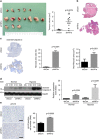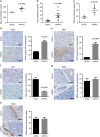In vivo functional dissection of a context-dependent role for Hif1α in pancreatic tumorigenesis
- PMID: 27941931
- PMCID: PMC5177776
- DOI: 10.1038/oncsis.2016.78
In vivo functional dissection of a context-dependent role for Hif1α in pancreatic tumorigenesis
Abstract
Hypoxia-inducible factor 1α (Hif1α) is a key regulator of cellular adaptation and survival under hypoxic conditions. In pancreatic ductal adenocarcinoma (PDAC), it has been recently shown that genetic ablation of Hif1α accelerates tumour development by promoting tumour-supportive inflammation in mice, questioning its role as the key downstream target of many oncogenic signals of PDAC. Likely, Hif1α has a context-dependent role in pancreatic tumorigenesis. To further analyse this, murine PDAC cell lines with reduced Hif1α expression were generated using shRNA transfection. Cells were transplanted into wild-type mice through orthotopic or portal vein injection in order to test the in vivo function of Hif1α in two major tumour-associated biological scenarios: primary tumour growth and remote colonization/metastasis. Although Hif1α protects PDAC cells from stress-induced cell deaths in both scenarios-in line with the general function Hif1α-its depletion leads to different oncogenic consequences. Hif1α depletion results in rapid tumour growth with marked hypoxia-induced cell death, which potentially leads to a persistent tumour-sustaining inflammatory response. However, it simultaneously reduces tumour colonization and hepatic metastases by increasing the susceptibility to anoikis induced by anchorage-independent conditions. Taken together, the role of Hif1α in pancreatic tumorigenesis is context-dependent. Clinical trials of Hif1α inhibitors need to take this into account, targeting the appropriate scenario, for example palliative vs adjuvant therapy.
Figures




References
-
- Koong AC, Mehta VK, Le QT, Fisher GA, Terris DJ, Brown JM et al. Pancreatic tumors show high levels of hypoxia. Int J Radiat Oncol Biol Phys 2000; 48: 919–922. - PubMed
-
- Semenza GL. Regulation of mammalian O2 homeostasis by hypoxia-inducible factor 1. Annu Rev Cell Dev Biol 1999; 15: 551–578. - PubMed
LinkOut - more resources
Full Text Sources
Other Literature Sources

